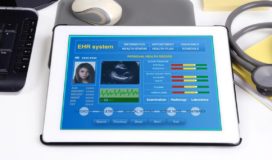Privacy and Security of Electronic Health Records
With the advent of information technology, almost every field is affected by the innovative products that are making our life smoother. The case is pretty much similar in the health industry as well. Nowadays, all the information of the patient is recorded into e-system (EHR & EMR) which enables healthcare providers to quickly access their medical information and provide right treatment within the desired time span. In addition to this, EHR allows the sharing of the medical information among all the healthcare providers for patient’s care.
What Are Electronic Health Records?
Electronic Health Records are digital versions of patients’ medical histories and health information. They can include details such as medical conditions, treatments, medications, test results, and personal details. Unlike paper records, EHRs are accessible from multiple locations and can be shared among different healthcare providers, making it easier to provide coordinated care.
Regulations and Standards
EHR is used to store the medical history of the patient among healthcare providers but have you ever thought about the data shared on the system. Is it secure enough to keep the data private and what if the data becomes public or someone tries to steal the data for the wrong purpose? These are the questions that come to mind when we think about the darker side of the EHR.
Fortunately, to address this problem there has been a law called HIPPA (Health Insurance Portability and Accountability Act) enacted to keep the data of the patient private and secure. However, the law does come with various conditions and standards that must be followed in order to keep the information of the patient safe and secure.
EHR is managed by the hospitals and doctors that help them in getting lots of advantages but a patient always has this right to keep his records private. Therefore it should be the responsibility of the providers to adopt such EHR that protects the data of the patient and keeps it private. An EHR system should be such that eliminates every threat to the security and privacy of the patient.
How Can EHR Be Secured?
Common Threats to EHR Security
Despite these regulations, EHRs face numerous security threats:
- Cyberattacks: Hackers and cybercriminals target healthcare organizations to steal sensitive information. Ransomware attacks, where hackers encrypt data and demand payment for its release, have become a significant concern.
- Insider Threats: Employees or contractors with access to EHRs might misuse their access for personal gain or due to negligence. This could include unauthorized viewing of patient records or accidental exposure of data.
- Data Breaches: Data breaches can occur due to system vulnerabilities, software bugs, or poor security practices. Once breached, patient information can be exposed or stolen.
- Phishing Scams: Phishing attacks trick individuals into providing sensitive information by pretending to be legitimate entities. In healthcare, phishing can lead to unauthorized access to EHRs.
Best Practices for Protecting EHRs
To safeguard EHRs, healthcare organizations should follow several best practices:
- Access Controls (Private Passkey) – The healthcare providers including doctor and nurses must have the access control to reach the required medical information of the patient. It is important because to make the necessary decisions and changes in the treatment of the patient there is the need for this access. Sharing of the private password between the right healthcare providers such as doctors and nurses will make the EHR more secured.
- Encryption of data – To make the data secure and out of the reach of the unauthorized users, the medical data of the customer must be encrypted properly.
- Use of software programs – The providers should make use of software programs to keep a watch on those people who accessed the medical data of the patient. These spy software will record the number of times the patient’s data is seen, at what time it is seen and what changes were made to the original data.
- Regularly Update Software – Keep all software, including EHR systems and associated applications, up to date. Regular updates and patches help protect against known vulnerabilities that could be exploited by attackers.
- Audit Trail – EHR system should get audit trail done to see if everything is there to keep the data secure. If any discrepancy is found then the necessary changes should be made and certain measures should be adopted to avoid further error.
- Educate Staff – Train healthcare staff on best practices for data security and privacy. This includes recognizing phishing attempts, handling data responsibly, and understanding the importance of protecting patient information.
- Backup Data – Regularly back up EHR data to ensure that information can be restored in case of a system failure, cyberattack, or other incidents. Backups should be stored securely and tested periodically.
Legal and Ethical Considerations
Legal and ethical issues surrounding EHRs add another layer of complexity to their management:
- Confidentiality: Patient confidentiality must be preserved at all times. Unauthorized disclosure of medical records, even inadvertently, can have serious consequences for patients and providers alike.
- Consent: Patients generally have the right to control who can access their health information. Consent processes need to be clear and transparent, ensuring that patients understand how their data will be used and shared.
- Data Ownership: There is ongoing debate about who owns electronic health records: the patient or the healthcare provider. Clarifying ownership rights and responsibilities is important for both legal and ethical reasons.
Patient Rights and Transparency
Patients also have rights concerning their health information. Under HIPAA, patients can request access to their own medical records, seek corrections to inaccurate information, and understand how their data is used and shared. Transparency about data practices helps build trust and empowers patients to be active participants in managing their health information.
The Future of EHR Security
As technology continues to evolve, so will the methods used to protect EHRs. Advances in artificial intelligence (AI) and machine learning are expected to play a significant role in identifying and responding to security threats more effectively. Additionally, emerging technologies such as blockchain could offer new ways to enhance data integrity and security.
The integration of privacy and security measures into the design and operation of EHR systems will be essential. Healthcare organizations, policymakers, and technology developers must work together to address security challenges and ensure that EHR systems remain secure and reliable.
Conclusion
The privacy and security of Electronic Health Records are vital to the effective functioning of the healthcare system. As technology continues to advance, healthcare organizations must remain vigilant and proactive in implementing and updating security measures. By addressing the challenges and embracing new technologies, we can help ensure that patient information remains safe and confidential, fostering trust and improving the overall quality of care.
Health IT



